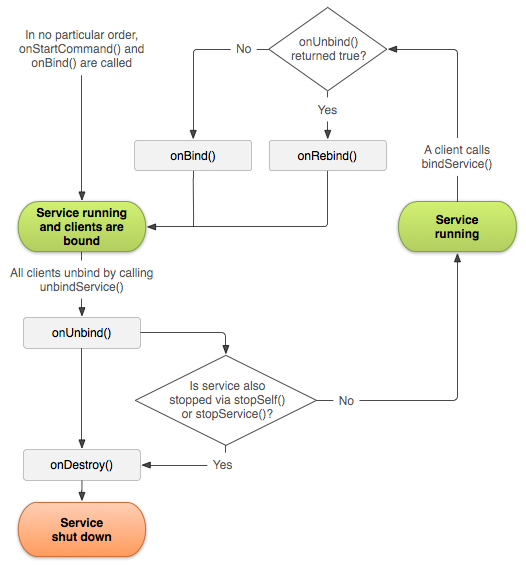Andorid总结 - Bound Services
2016-05-06 17:12
465 查看
创建一个Bound Service
想要创建一个提供binding的service,必须提供一个IBinder给client与service进行交互。有三种方式可以定义接口:继承Binder类
如果service只给自己的应用使用并且不会做跨进程的操作,我们可以继承Binder类并且通过onBind()返回一个它的实例。client接收到这个Binder可以直接使用它开调用service提供的方法。
使用步骤:
创建一个Binder实例,任意实现一种:
在Binder类中包含client可以访问的public方法。
返回一个当前Service的实例,client可以通过这个实例调用Service的public方法。
返回一个封装了service public方法的类对象,client可以调用。
通过onBind()回调函数返回Binder实例。
在client端,通过onServiceConnected()的回调函数接收Binder 对象,通过Binder对象来调用公开的方法。
例子,通过onBinder返回Service对象:
public class LocalService extends Service {
// Binder given to clients
private final IBinder mBinder = new LocalBinder();
// Random number generator
private final Random mGenerator = new Random();
/**
* Class used for the client Binder. Because we know this service always
* runs in the same process as its clients, we don't need to deal with IPC.
*/
public class LocalBinder extends Binder {
LocalService getService() {
// Return this instance of LocalService so clients can call public methods
return LocalService.this;
}
}
@Override
public IBinder onBind(Intent intent) {
return mBinder;
}
/** method for clients */
public int getRandomNumber() {
return mGenerator.nextInt(100);
}
}使用Messenger
如果service需要与别的进程进行交互,那么可以使用Messenger提供的接口来实现service。这个技术不需要使用AIDL就能实现IPC。
Messenger的使用方法:
service需要实现一个Handler来接收client调用时传递过来的callback。
通过Handler来创建一个 Messenger对象。
这个Messenger 对象创建一个IBinder,提供给onBind()返回给client。
Clients 使用 IBinder来初始化这个Messenger (that references the service’s Handler), client可以使用这个Messenger 来给service发送Message对象。
Service中实现的Handler会接收并处理接收到的Message。
使用Messenger来实现的Service实例:
public class MessengerService extends Service {
/** Command to the service to display a message */
static final int MSG_SAY_HELLO = 1;
/**
* Handler of incoming messages from clients.
*/
class IncomingHandler extends Handler {
@Override
public void handleMessage(Message msg) {
switch (msg.what) {
case MSG_SAY_HELLO:
Toast.makeText(getApplicationContext(), "hello!", Toast.LENGTH_SHORT).show();
break;
default:
super.handleMessage(msg);
}
}
}
/**
* Target we publish for clients to send messages to IncomingHandler.
*/
final Messenger mMessenger = new Messenger(new IncomingHandler());
/**
* When binding to the service, we return an interface to our messenger
* for sending messages to the service.
*/
@Override
public IBinder onBind(Intent intent) {
Toast.makeText(getApplicationContext(), "binding", Toast.LENGTH_SHORT).show();
return mMessenger.getBinder();
}
}一个调用Messenger实现的Service的客服端实例:
public class ActivityMessenger extends Activity {
/** Messenger for communicating with the service. */
Messenger mService = null;
/** Flag indicating whether we have called bind on the service. */
boolean mBound;
/**
* Class for interacting with the main interface of the service.
*/
private ServiceConnection mConnection = new ServiceConnection() {
public void onServiceConnected(ComponentName className, IBinder service) {
// This is called when the connection with the service has been
// established, giving us the object we can use to
// interact with the service. We are communicating with the
// service using a Messenger, so here we get a client-side
// representation of that from the raw IBinder object.
mService = new Messenger(service);
mBound = true;
}
public void onServiceDisconnected(ComponentName className) {
// This is called when the connection with the service has been
// unexpectedly disconnected -- that is, its process crashed.
mService = null;
mBound = false;
}
};
public void sayHello(View v) {
if (!mBound) return;
// Create and send a message to the service, using a supported 'what' value
Message msg = Message.obtain(null, MessengerService.MSG_SAY_HELLO, 0, 0);
try {
mService.send(msg);
} catch (RemoteException e) {
e.printStackTrace();
}
}
@Override
protected void onCreate(Bundle savedInstanceState) {
super.onCreate(savedInstanceState);
setContentView(R.layout.main);
}
@Override
protected void onStart() {
super.onStart();
// Bind to the service
bindService(new Intent(this, MessengerService.class), mConnection,
Context.BIND_AUTO_CREATE);
}
@Override
protected void onStop() {
super.onStop();
// Unbind from the service
if (mBound) {
unbindService(mConnection);
mBound = false;
}
}
}Using AIDL
Binding to a Service
想要绑定Service,Client需要实现:实现ServiceConnection接口,必须实现两个方法。
onServiceConnected(),系统会调用这个函数用于返回IBinder。
onServiceDisconnected(),当连接异常断掉之后,系统会调用这个函数。unbind的时候不会调用。
调用bindSercie,把ServiceConnection 作为参数传递过去。
当系统调用onServiceConnected() 之后,就可以 通过获取到的IBinder来调用service公开的方法。
调用unbindService()来断开连接。
实现ServiceConnection的实例:
LocalService mService;
private ServiceConnection mConnection = new ServiceConnection() {
// Called when the connection with the service is established
public void onServiceConnected(ComponentName className, IBinder service) {
// Because we have bound to an explicit
// service that is running in our own process, we can
// cast its IBinder to a concrete class and directly access it.
LocalBinder binder = (LocalBinder) service;
mService = binder.getService();
mBound = true;
}
// Called when the connection with the service disconnects unexpectedly
public void onServiceDisconnected(ComponentName className) {
Log.e(TAG, "onServiceDisconnected");
mBound = false;
}
};调用bindService():
Intent intent = new Intent(this, LocalService.class); bindService(intent, mConnection, Context.BIND_AUTO_CREATE);
bindService的第三个参数指示binding时的选项。通常应该设置为BIND_AUTO_CREATE 。还可以为BIND_DEBUG_UNBIND 和BIND_NOT_FOREGROUND, 或者设为0代表什么都不选.
Additional notes
binding to a service的时候有几个注意事项:应该总是捕捉DeadObjectException 异常, 这种异常会在链接被破坏掉的时候抛出来。 这是远程方法会抛出的唯一的一种异常。
跨进程处理的时候,Object的引用会被计数。
需要在client的生命周期中成对的使用binding和unbinging。例如:
如果只需要在Activity可见的时候使用service,应该在onStart的时候bind servcie,在onStop的时候unbind srvice。
如果想Activity在后台的时候也与service交互,那么在onCreate的时候bind service,在onDestroy的时候unbind service。
管理Bound Service的生命周期

相关文章推荐
- 使用C++实现JNI接口需要注意的事项
- Android IPC进程间通讯机制
- Android Manifest 用法
- [转载]Activity中ConfigChanges属性的用法
- Android之获取手机上的图片和视频缩略图thumbnails
- Android之使用Http协议实现文件上传功能
- Android学习笔记(二九):嵌入浏览器
- android string.xml文件中的整型和string型代替
- i-jetty环境搭配与编译
- android之定时器AlarmManager
- android wifi 无线调试
- Android Native 绘图方法
- Android java 与 javascript互访(相互调用)的方法例子
- android 代码实现控件之间的间距
- android FragmentPagerAdapter的“标准”配置
- Android"解决"onTouch和onClick的冲突问题
- android:installLocation简析
- android searchView的关闭事件
- SourceProvider.getJniDirectories
